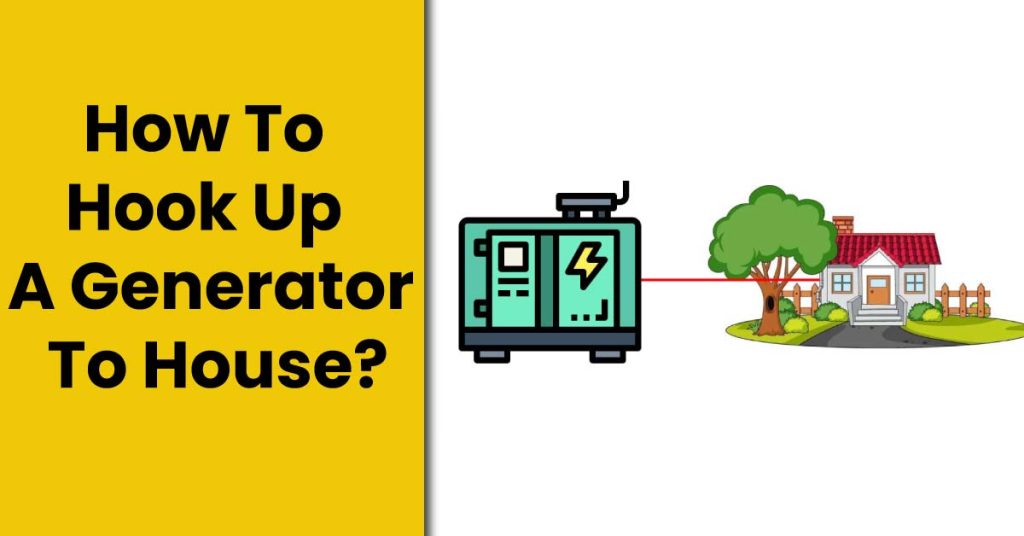How To Hook Up A Generator To House? – Step By Step Guide
For emergency preparedness plans, a generator is the core component of everyone’s life. A generator is a perfect solution in case of an electrical power outage from the national grid or due to any other crucial reason. Though it is not mandatory for a generator to supply power to all the appliances at home but to provide electricity to only essential items such as lights, TV, fridge, stoves, air conditioners, etc. Appliances such as air conditioners, and stoves consume more power as compared to other devices.
The legal and proper way to power up your home in an emergency situation is only possible by a generator transfer switch. Although built-in transfer switches are a bit more expensive, they are worth it due to safety reasons.
In this article, we are going to deliver detailed instructions on how to hook up a generator to a house.
Use A Transfer Switch To Connect the Generator To the House
A transfer switch is an important aspect of running a generator in the best and safest possible way. It isolates the electrical load while allowing your supplies to run smoothly by the power of the generator without any resistance.
The transfer switch is capable of preventing electricity from the generator to flow outward onto the city power lines that otherwise can endanger the people who may be working on those utilities during the power outage.
There are three major types of transfer switches that are described below with varying expense, complexity, and benefits.
Automatic Transfer Switches:
An automatic transfer switch can sense power loss, power up your standby generator as well as automatically move all load to the generator. These are some of the amazing features that can be availed in standby generators with the help of these transfer switches.
No doubt in their effectiveness, but they require a full-time dedicated standby generator and are very expensive.
Manual Transfer Sub Panel Switches:
Another good option to go is a manual transfer sub panel switch that is less expensive as compared to an automatic transfer switch and can easily be used with a portable generator. But there is one downside of them, that they typically cover only a few breakers which are quite problematic.
Breaker Interlock
It is one of the wise options to choose as it is compliant with the National Electric Code and the least expensive. Switching to this will be easy and safe for you due to its flexibility of options.
Manual vs. Universal Transfer Switches
A manual transfer switch works similarly to the traditional breaker boxes. While a universal switch automates the process within just milliseconds.
A manual transfer switch turns the breaks up and out automatically to draw the overall power above the maximum load of the power system. Meanwhile, a universal transfer switch is also beneficial as it can detect the failure power of the utility grid and then switches back to the generator.
Some also have a battery backup to keep appliances running until power is turned off whenever the generator is off. In case of power goes back, a universal switch will automatically switch to the electric grid.
More setup is needed in the case of the universal transfer switch. You can easily purchase a universal transfer switch at any hardware store but the manual transfer switches are only accessible at rental companies.
How to Connect A Generator To House (Step By Step Guide)

The step-by-step guide on how to hook up a generator to a house is described below:
Determine Your Generator Plug Type And Amperage:
The first most important thing you need to do is to figure out the type of amperage and plug type that you are working with. You may need to do this on a generator having a big round plug. It will deliver 220V and power up both sides of your breaker box.
The amperage written near the plug will be visible to you. So, you can check it from there.
Required Tools & Equipment:
For the purpose of hooking up a generator to a house, you’ll need the following supplies to gather before starting the process.
Breaker Interlock Kit:
You may need to buy a UL-rated device that will fit your specific breaker box. As they are tested and validated to do their work.
Double Breaker:
30 Amp 3 pole double breaker will also be required to make it fit your breaker box. In fact, all breakers are not the same.
Wire:
Wire in red, green, white, and black colors will be needed.
- 30 Amp power Inlet box
- Conduit body
- Conduit glue
- Flexible Non-Metallic Conduit and fittings
- 30 Amp generator extension cord
Keep in mind the amperage match. In case of utilizing 50 output on your generator, there will be a need for a 50 Amp breaker, 50 Amp extension cable, 50 Amp power inlet box as well as the 8-gauge wire.
Drill Access Hole:
If there is a conduit old hole already present then you just need to find it and there is no need to drill a new hole. Otherwise, drill a hole with the hammer or a drill machine whatever you find easily accessible. But try to get the hole as close to the panel as you can.
Mount Power Inlet Box:
Now you need to remove the front cover from the power inlet box. To do this, remove a knockout and place a PVC fitting. You can rely on the watertight connector or even glue.
You can also use tap cons to mount the power inlet box onto the wall.
Test Fit And Glue Conduit:
With the help of a hack saw, cut the conduit to its length. Do not glue it until you are sure that it is fitting well.
Once it is fit, glue it down.
Wire The Generator Inlet Plug:
After drying up the glue, you can start working on the wiring. For this, remove the cover on the conduit body, pull wires through one at a time while attaching them to the plug as you go along.
Then remove almost ¾ inches of insulation. Use a large flat screwdriver or a nut driver to make the terminals tighter.
- The green wire should be grounded to the power inlet box.
- The white wire should be common to the W terminal.
- While the black and red wires should be loaded either to X or Y terminal.
- Push Wiring Inside
Push all the wires through the conduit to the house at once. Then replace the conduit body cover while checking the proper fit of the gasket.
Fill gaps if there is any between the conduit and the house, with the help of silicone or expanding foam.
Prep Breaker Box For Wires:
Now turn off all the branch breakers as well as the main power breaker. Then remove the front panel of the breaker box by removing four screws.
Detach the knockout and screw in the conduit adapter. Now pull the wires through the conduit and put them inside the box.
Create Open Breaker Space:
The breaker interlock technique requires the right and most upper breaker space to be free. In general, there will be a need to move a breaker or two down. Some boxes already have enough spare wires to move things around. If the room is insufficient, and your breaker is 30 Amp or less, you can use a small piece of insulated wire and a wire nut.
Note: Never wire nut copper and aluminum wire together as they will corrode over time. You will need to pick up a wire splice at a local home store.
Install Generator Breaker And Wires:
Now is the time to install a new breaker in the free space in the upper right of the breaker box.
The red wire moves to one terminal of the breaker, while the black one reaches the other side.
The white wire is placed to the common bond rail in the box and the green wire goes to the ground rail.
Note: If your home is 2 wire or there is no third ground wire in the outlet box or outlets in the home, then it is permissible to put the green ground wire to an open terminal.
Although, it won’t be good to use the ground wire for the common at the outlet.
Install Breaker Retainer:
It is better to lock down the breaker from moving anywhere. To do this, you’ll need to install a retaining bracket.
Install Interlock On Panel Cover:
Overturn the cover and use the templates that have been provided. The next thing you should do is to pre-drill the holes and finish them out in bit size as noted in your instructions.
Then flip the panel back on its position and install sliding interlock bolts. Reinstall the panel with all of its breakers in the off place. While the main is in the off position, turn the breaker of the generator to the on position.
Make sure the interlock allows for exact position. You may also need to shift the position of the panel cover.
Now turn off the breaker of the generator and drop the slide to prevent it from turning on. Also, assure to turn on the main position while adjusting the panel cover if it is not.
If the breakers turn on at once, with a delay of 5 seconds between breakers, it will distribute the startup load.
Then attach the labels present in your kit to the breaker box and outside of the service box.
Check out our guide about How To Polarize A Generator
Operating Steps
As we have done adjusting the parts in their right position, now we are going to run a test to find out the required results.
For Power Off Sequence:
As the setup has been done, now enjoy using your generator.
How To Hook Up A Generator To Your House Without A Transfer Switch
To learn about how to hook up a generator to your home without a transfer switch, visit the link.

Josh is a highly skilled electrician with specialized expertise in the field of generators. With years of experience under his belt, he has established himself as an expert in all aspects of generators, ranging from installation and maintenance to troubleshooting and repairs. Josh’s in-depth knowledge of electrical systems and his commitment to staying updated with the latest industry advancements make him a reliable and sought-after professional.
